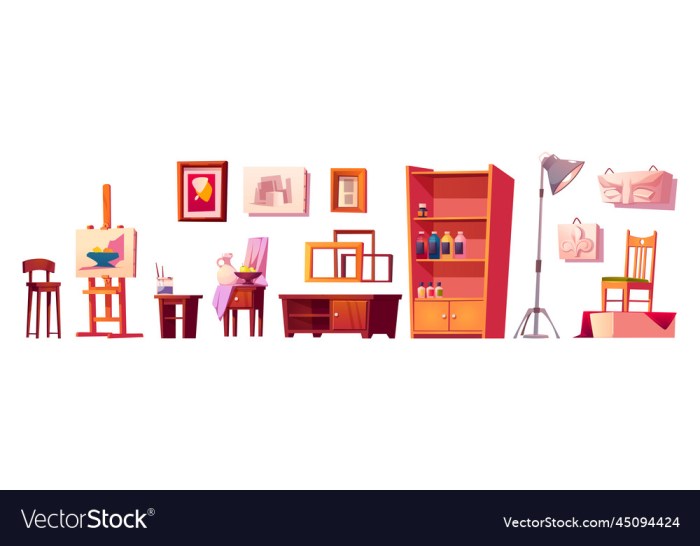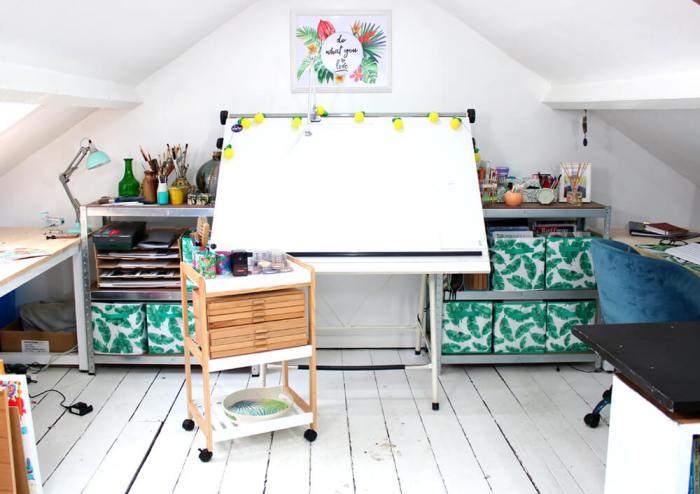Studio furniture for artists is far more than just functional; it’s an integral part of the creative process. The right pieces can enhance workflow, inspire innovation, and even protect valuable artwork. From sturdy easels and adjustable drafting tables to specialized storage solutions, the choices available significantly impact an artist’s comfort, efficiency, and overall artistic expression. This exploration delves into the key considerations for selecting and arranging studio furniture to create an optimal workspace.

Careful consideration of space, materials, and functionality are crucial when equipping an artist’s studio. Ergonomics play a vital role in preventing injuries and ensuring long hours spent creating are comfortable. Investing in high-quality, durable furniture is an investment in the longevity of an artist’s career and the preservation of their work. The style of the furniture should also complement the artist’s aesthetic and overall creative vision, fostering a harmonious and inspiring environment.
Creating a functional and inspiring art studio is crucial for any artist, regardless of their discipline. The right furniture can significantly impact your workflow, comfort, and overall creative process. This comprehensive guide explores the essential studio furniture pieces for artists, considering various artistic mediums and individual needs. We’ll delve into the specifics of each piece, offering advice on choosing the best options to maximize your creative space and efficiency.
Essential Studio Furniture for Artists
The core furniture pieces for an artist’s studio depend heavily on the chosen medium. However, some items are universally beneficial, providing a solid foundation for any creative workspace.
1. Easels
The Artist’s Canvas Support
Easels are indispensable for painters and other artists working with large canvases or boards. Different easel types cater to diverse needs.
- H-frame easels: These are sturdy and portable, ideal for both studio and plein air painting. They offer adjustable height and tilt.
- Tabletop easels: Compact and perfect for smaller canvases or quick sketches, these are excellent space-savers.
- French easels: Known for their elegant design and stability, they are suitable for larger canvases and offer excellent adjustability.
- A-frame easels: Simple and lightweight, these are a good budget-friendly option for beginners.
Consider factors like height adjustability, stability, weight capacity, and portability when choosing an easel. The size of your canvases will also dictate the appropriate easel size.
2. Workbenches and Tables
A Solid Foundation for Creation
A sturdy workbench or table is vital for preparing materials, mixing paints, and performing other tasks requiring a stable, flat surface. The ideal size and design depend on the artist’s needs and the space available.
- Adjustable height workbenches: These allow artists to customize their working height for optimal ergonomics and comfort, reducing strain on the back and neck.
- Multi-purpose tables: These can serve as both a workbench and a display area, offering versatility in a limited space.
- Rolling carts: These provide mobile storage and workspace, ideal for transporting materials and tools around the studio.
When selecting a workbench or table, consider durability, material (wood, metal, or composite), and the inclusion of features like drawers, shelves, or pegboards for storage.
3. Storage Solutions
Keeping Your Studio Organized
Maintaining a well-organized studio is key to productivity and creativity. Effective storage solutions prevent clutter and allow for easy access to materials and tools.
- Cabinets and drawers: These provide secure storage for valuable materials and delicate tools.
- Shelving units: These offer versatile storage for larger items, such as canvases, frames, and books.
- Pegboards: These allow for customizable storage of tools and smaller items, keeping them within easy reach.
- Storage containers: Clear containers are ideal for organizing smaller items and keeping them dust-free.
Consider using labeled containers to maintain a system of organization and easily locate specific items. Vertical storage solutions maximize space in smaller studios.
4. Chairs and Seating
Comfort and Ergonomics
Spending long hours in the studio requires comfortable and ergonomically sound seating. Choosing the right chair can prevent back pain and fatigue.
- Adjustable chairs: These allow you to customize the height and back support for optimal comfort.
- Drafting chairs: These offer adjustable height and a swivel seat, ideal for artists who work at standing height.
- Stools: These are suitable for shorter periods of sitting or for use in conjunction with a standing desk.
Prioritize chairs with good lumbar support and adjustability to ensure proper posture and comfort during extended work sessions.
5. Lighting
Illuminating Your Creative Space
Proper lighting is essential for accurate color perception and reducing eye strain. A combination of ambient, task, and accent lighting is recommended.

- Natural light: Maximize natural light sources whenever possible, as it provides the most accurate color rendering.
- Task lighting: Use adjustable desk lamps or floor lamps to illuminate your work area directly.
- Ambient lighting: Provide general illumination throughout the studio to create a comfortable and inviting atmosphere.
Consider using full-spectrum light bulbs to mimic natural daylight and ensure accurate color representation.
Choosing the Right Studio Furniture: Factors to Consider
Selecting the appropriate studio furniture requires careful consideration of several factors:
- Your artistic medium: Painters need easels and ample surface space, while sculptors require sturdy workbenches and possibly specialized tools.
- Your budget: Studio furniture ranges in price, so setting a budget is essential before making purchases.
- Your studio space: Measure your studio carefully to determine the appropriate size and layout of your furniture.
- Your personal preferences: Choose furniture that you find aesthetically pleasing and comfortable to work with.
- Durability and quality: Invest in high-quality furniture that will last for years to come.
Frequently Asked Questions (FAQ)
- Q: What type of easel is best for beginners? A: A-frame easels are generally a good starting point due to their affordability and ease of use.
- Q: How much space do I need for an art studio? A: The required space depends on your medium and the scale of your work. A minimum of 100 square feet is often recommended, but larger spaces are preferable.
- Q: What is the best type of lighting for an art studio? A: A combination of natural light, task lighting, and ambient lighting is ideal. Full-spectrum bulbs are recommended for accurate color rendering.
- Q: How can I organize my art supplies effectively? A: Utilize a variety of storage solutions such as cabinets, shelves, pegboards, and clear containers. Label everything for easy access.
- Q: Where can I find affordable studio furniture? A: Check online marketplaces, thrift stores, and discount retailers for budget-friendly options. Consider building some pieces yourself.
Resources: Studio Furniture For Artists
- Artists & Illustrators Magazine
-Offers advice and inspiration for artists. - Artnews
-Provides news and insights into the art world.
Call to Action
Create your dream art studio today! Invest in the right furniture to enhance your creativity and productivity. Start browsing for your perfect studio essentials now!
User Queries
What materials are best for studio furniture?
Durable materials like wood, metal, and high-quality plastics are ideal. Consider factors like durability, cleanability, and resistance to wear and tear from art supplies.
How much space do I need for my art studio?
The space required depends on your art form and the scale of your projects. Plan for ample room for your chosen furniture and materials, allowing for comfortable movement.
Where can I find affordable studio furniture?

Online marketplaces, secondhand stores, and even repurposed furniture can offer cost-effective options. Prioritize quality over brand name where possible.
